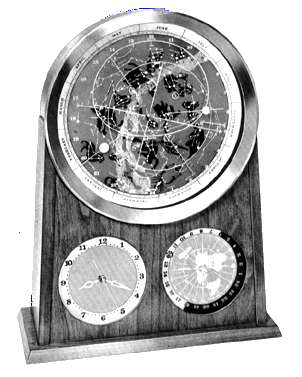
Index
Manual (online or pdf format)
Spilhaus Clock Designed by Dr. Athelstan Spilhaus
The following appears in booklet 1300, "Lots of Time", published by Edmund Scientific Co., Barrington, New Jersey in 1964.
"Dr. Athelstan Spilhaus, Dean, Institute of Technology, University of Minnesota, is well known to scientists the world over. He is listed in "American Men of Science" as a meteorologist, an oceanographer, and as the inventor of the bathythermograph, an invention which contributed substantially to our submarine warfare success in WW II."
"Through his meteorological work, Dr. Spilhaus has long had a keen interest in astronomical clock, their history and function. Years ago he conceived the idea of a compact space clock utilizing modern materials not available to early clock makers. Over a period of six years he developed the simple, unique gearing for the various discs of the space dial. He built several models, and finally produced a design for a clock that is considered by many to be a breakthrough in the art and science of clock making.
When Dr. Spilhaus gave Edmund Scientific Co. the opportunity to manufacture and market the clock, they eagerly accepted the privilege. Edmund Scientific Co. has for over 21 years been a well known source of supply for scientists, teachers, hobbyists, and amateur astronomers. In the manufacturing of this unique instrument, everything consistent with good engineering practice has been done."
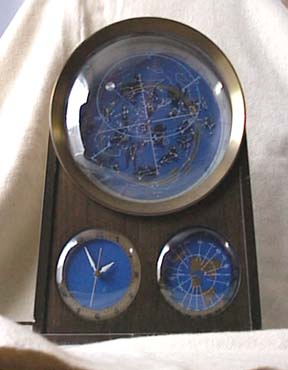
The clock has three dials. The lower left dial is a standard 12 hour clock, showing time in hours, minutes and seconds. The small dial on the right contains a map of the world and the 24 hour marks around the edge. The outside of the dial rotates, showing the time anyplace in the world.
The upper dial is actually a series of clear discs. For example, the back disc shows the various constellations in the sky, while other discs show the position of the sun and moon, tides, the horizon and what is currently visible. The discs rotate at different rates, each showing the correct information.
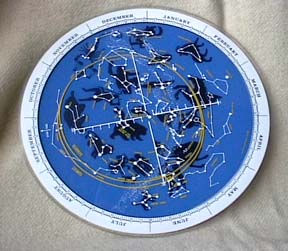
The zodiac dial shows the position of the stars and constellations and the current month.
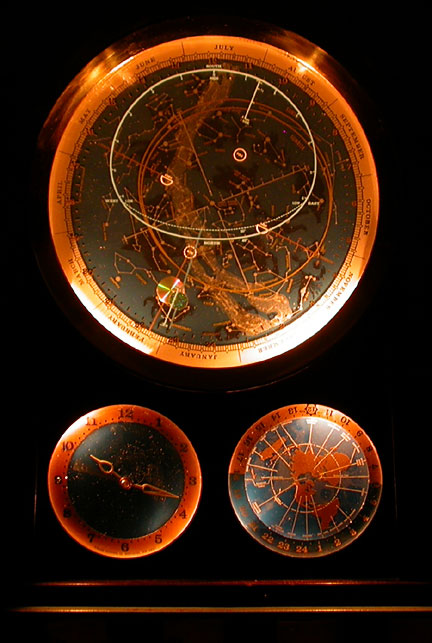
The dials look impressive when lit. The telephone bulbs are wired in series and show a soft yellow light..
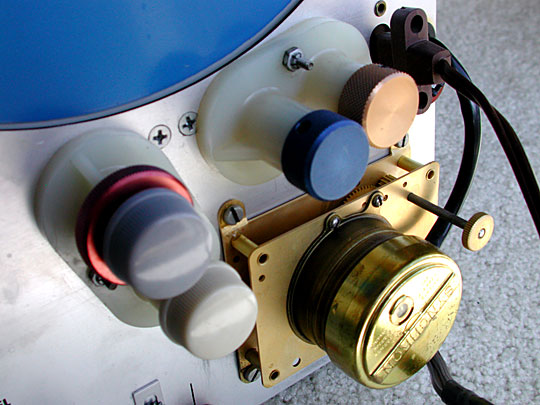
The back of the clock shows the various knobs used to set the time and position of the dials in the front. Each knob is color coded depending on which function they will control. Setting the correct posistions of all the discs is complicated but the manual carefully illustrates the correct proceedure.
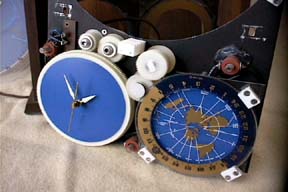
When the works are removed from the case, the various gears become visible. The 12 hour dial turns the rest of the gear train. The 24 hour dial shows the outside hour markings that surround the world map.
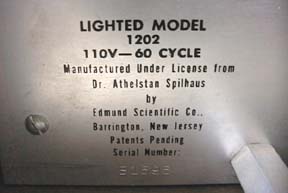
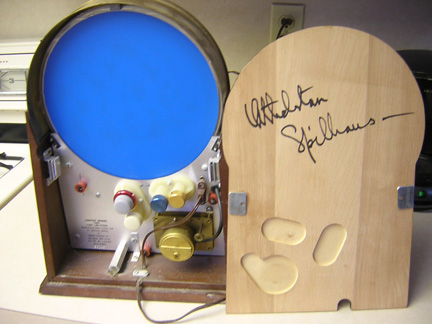
Chuck Kichline found the signature in the back of the clock.
My Clock
I first saw my Spilhaus clock while visiting my future grand-parents-in-law. Their clock was beautiful and I was entranced. I admired it and told my girlfriend how wonderful it was. Later, when my girlfriend became my wife, she presented the clock to me as a wedding present.
I found it suffered from broken gears. The gears are Nylon and are pressed over metal bushings. The Nylon, made long ago, shrinks, becomes brittle, and splits. The clock will no longer work.
I sent the clock to Edmunds Scientific for repair. They repaired the clock with the gears they have in stock and sent the clock back. Since the gears were made at the same time as the original gears in the clock, they soon split as well. Contacting Edmunds several years later, I found they were no longer willing to repair the clocks. They did send me several replacement parts and gears, and I was able to get my clock running again.
Index
Manual
A pdf of the original manual, "Lots of Time", is in a small format.
The clock comes with a detailed instruction book called "Lots of Time." My daughter converted the manual to html format for publishing on the internet. She did an exceptional job, scanning in the pictures, writing html code without the aid of a graphical editor, and checking her results. Please refer to it when you want to learn more about your clock. The manual includes instructions on how to set the various dials and discs. This manual does not require a pdf reader to view.
Patent
The original patent for the clock was issued to Dr. Athelstan Spilhaus on May 3, 1966. It was number 3,248,866.
The patent provides information on how the various discs rotate and how the clock is constructed. It shows each one of the dials and the various markings.
Spilhaus Clock Construction Explained
"The Best Of J.E. Coleman: Clockmaker" is a book that answers many questions about clocks. It contained a wonderful description of the Spilhaus Space Clock from a gear train and construction perspective. However covered the Nylon gears and repair lightly if incorrectly.
Repairing
Many people purchase the clock and assume it is in working condition. Unfortunately the 12 hour clock will work but it will be difficult to determine if the rest of the dials are turning at the correct rate. I have never found a clock in original condition that was working. They all have some split gears and while they may be turning they are slow ling losing time.
Removing the works from the case.
Examining, sourcing, and replacing the cracked gears.
Replacing the telephone lamps.
Replacing the Synchron motor and clock train.
Clock Memories
Many people remember the old Edmunds Scientific catalogs. I enjoyed reading them as a kid, thinking of all the wonderful experiments I could perform with the items listed. Bruce remembers the clock and sends a note to his brother.
David's Spilhaus Clocks
David R. Webb has a series of pictures, both of dials and of the clocks themselves, showing the differences between a prototype, lighted and unlighted models.
